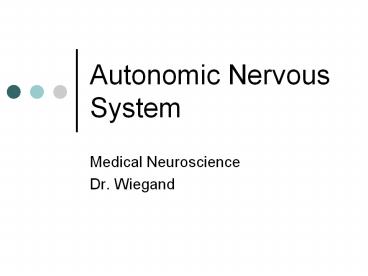Autonomic Nervous System - PowerPoint PPT Presentation
Title:
Autonomic Nervous System
Description:
Autonomic Nervous System Medical Neuroscience Dr. Wiegand Autonomic Nervous System Enteric System Sympathetic Nervous System Parasympathetic Nervous System All ... – PowerPoint PPT presentation
Number of Views:118
Avg rating:3.0/5.0
Title: Autonomic Nervous System
1
Autonomic Nervous System
- Medical Neuroscience
- Dr. Wiegand
2
Autonomic Nervous System
- Enteric System
- Sympathetic Nervous System
- Parasympathetic Nervous System
- All systems have GVE and GVA components
- Primarily considered a
- two neuron chain motor system
3
Autonomic Nervous System
4
Skeletal vs. Smooth MuscleMotor Systems
5
PSNS SNS Similarities
6
PSNS SNS Differences
- SNS
- activate body
- thoracolumbar (T1-L2)
- short preganglionic/long postganglionic fibers
- global responses
- postganglionic transmitter norepinephrine
(except sweat glands ACH)
- PSNS
- prepare body for rest
- craniosacral (CN III, VII, IX, X S2-4)
- long preganglionics/short postganglionic fibers
- discrete/local responses
- postganglionic transmitter acetylcholine
7
(No Transcript)
8
Sympathetic Nervous System
- Fight or Flight system
- Activation
- increases heart rate
- increases sweating
- dilates pupil
- inhibits GI movement
- closes sphincters
- diverts blood from skin and GI tract to skeletal
muscles
9
(No Transcript)
10
Sympathetic Nervous System- Preganglionic Neuron
May
- terminate on postganglionic neuron in the
sympathetic chain ganglia - ascend or descend to higher or lower ganglia and
terminate on postganglionic neuron in the
sympathetic chain ganglia - pass through the sympathetic chain to
prevertebral ganglia (celiac, inferior or
superior mesenteric) - pass through the sympathetic chain ganglia to
adrenal medulla
11
- referred pain
- heart T1-4
- gall bladder T6-8
- stomach T7-8
12
(No Transcript)
13
- preganglionic fibers from T1-5 ascend
- postganglionic fibers from sup. cervical ganglia
follow carotid a. - fibers follow III and V ophthalmic
- innervate dilator m, levator palpebrae, sweat
lacrimal glands
14
Parasympathetic Nervous System
- prepares body for rest
- promotes digestion, GI peristalsis
- slows heart rate
- constricts pupil
- empties bladder
- relaxes sphincters
- mediates genital erection
15
(No Transcript)
16
Horners Syndrome
- damage to the descending fibers from the
hypothalamus or the superior cervical ganglia - miosis pupillary constriction
- anhidrosis lack of sweating
- ptosis drooping of the eye lid
- enophthalmos eye appears to sink in to the orbit
17
Bladder
- SNS retention
- PSNS voiding (micturation)
18
L1 L2 GVE
- SNS input from L1-2 (int. urinary sphincter)
- PSNS input from S2-4 (detrusor mm)
- GSE (Onuf) to ext. urinary sphincter
- GSA (pain, temp pressure to T12/L1 S2-4
- GVA to S2-4
- paracentral lobule brainstem
S2 S4 GVE
S2 S4 GSE
S2-4 GVA/GSA (T12/L1)
19
Autonomic Nervous System and the Bladder
- UMN bladder spastic bladder automatic
reflex bladder - LMN bladder flaccid bladder atonic
bladder autonomous reflex bladder
20
(No Transcript)
21
(No Transcript)































